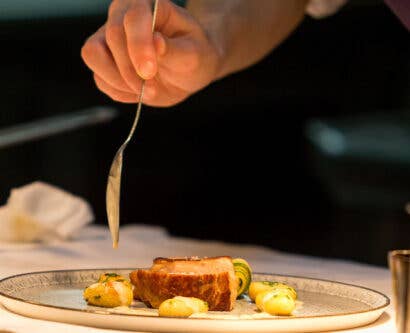How to Become a Food Blogger: Tips & Ideas
People have always loved and appreciated food. Whether it’s home cooking to be proud of, or a particularly beautiful dish from a local restaurant, photographing and showing off food has only grown in popularity. This is, in large part, due to the emergence of certain social media platforms that make it simple and easy for anyone to share their photos and creations online.
Some people, however, have managed to turn this passion into a career through food blogging, by writing and posting photos and recipes online. In fact, the hashtag #foodblogger now has 58.3 million posts on Instagram.
In this article, we will outline what it means to be a food blogger, explain how some people are able to make a career out of it, and what you may need in order to follow in their footsteps. We will also share some tips to keep in mind when starting a successful food blog.
- What is Food Blogging?
- Benefits of Food Blogging
- What Do I Need to Become a Food Blogger?
- How Do Food Bloggers Make Money?
- Content Ideas & Tips for Starting a Food Blog
What is Food Blogging?
This may seem like a simple question to answer, and yet, there isn’t a concrete definition for what a food blogger is. A blog is an online journal – a place to share your thoughts with as little or many people as you like – or a website that displays information about a particular topic.

It’s not surprising that blogging has grown exponentially in recent years. We’ve seen the rise of digital media, which is only going to continue to grow in popularity, and new social media platforms pop up every other week. Therefore, people have seen an opportunity to forge their own careers in blogging through these mediums. After all, people may still enjoy buying recipe books, but the internet is a chasm of infinite information on just about anything to do with food. Why not take advantage of that?
Essentially, in the broadest of terms, food blogging is the byproduct of a love for food and wanting to share that with the world.
Types of Food Blogs
‘Food blogging’ is a blanket term that covers all kinds of different content. Some of the most common and popular types of food blogs include:
- Cooking and Posting Blogs – These blogs are the most common, as their subject matters tend to be broader than others. The most successful ones create and promote their own recipes alongside photos of the food they have cooked, however, it is also possible to recommend other people’s recipes, too. Jane’s Patisserie is an example of a successful cooking and posting blog.
- Niche Blogs – These blogs focus on one specific element of food, such as vegan foods or gluten-free foods and tend to include information on their lifestyle that accompanies the food they promote. Again, they may include their own recipes, or merely suggest others that they’ve found helpful. Ultimately, they are committed to focusing on only one aspect of food. My Gluten Free Guide is one such blog.
- Food Reviewing Blogs – These kinds of blogs actively try different foods and write about their experiences. They usually include anecdotes about how they discovered what they’re trying, and can include reviews on recipes, cookbooks, restaurants, and more. A Girl Has to Eat is an example of a successful reviewing blog.

Benefits of Food Blogging
As with starting any food business from home, if you decide to make a career out of food blogging, it’s going to take a lot of time, energy, and hard work. There are, however, a number of enticing benefits that come with having a career as a food blogger, and we’re going to have a look at those now.
You’ll be your own boss
As a food blogger, you’ll have complete control of your schedule – from which days you work to what time you want to start each morning. Besides, creating something of your own from scratch is enormously gratifying and you’ll get a great sense of accomplishment.
There’s also the benefit with blogging to be able to keep your day job – at least to begin with! You can then build up your success on the side by putting in as much time as you can spare.

Low start-up costs
The beauty of blogging is how inexpensive it is. You’ll need little more than a passion for food and a phone capable of taking photos and handling social media apps. Some bloggers work from a computer or a laptop, while others merely post from their phone.
You’ll need a blogging platform to get started, however, many of these offer basic subscriptions for free and offer discounts for buying a yearly subscription rather than a monthly one. You can always pay for the premium subscriptions, which offer more benefits, but this is entirely your choice.
If you’re cooking or baking your own food, you’ll also need to factor in the cost of ingredients. Remember, though, that in order to get a fabulous photo of a brownie, you don’t need to cook a batch of 24. You can be smart with your use of ingredients and keep these costs low.
The creativity and appreciation
There are few other jobs in the world that offer as much creative freedom as blogging does. There are no rules, the blogging world is your oyster, and you can write as much or as little as you like about the things you love. The choice about what you include in your content is entirely yours, and you’ll also be the one choosing the aesthetics for your website or the compositions of your photographs.
There’s a great satisfaction to be had from having people appreciate the things you love and have created, too. If you utilise social media to your advantage, or have a comments section on your blogging website, you can engage with your readers and feel the love they have for what you have created.
If you’re successful, you may also get invited to restaurants for tastings or other exciting social events.

You get to do what you love
Most importantly of all, your life will revolve around food. You’ll get to spend your days researching, trying new and innovative recipes, and creating your own. What could be better?
Back to TopWhat Do I Need to Become a Food Blogger?
So, now that you’ve decided to kickstart your blogging career – where do you start? By following a few crucial steps, you’ll be on your way to a successful career before you know it.
Find a Niche
The first, and arguably most important, step is to decide what kind of blog you are going to write, and what your niche is going to be. Just as with any business, it’s important to have a unique selling point – something that is original and inherently yours, that makes you stand out from others. There are an estimated 227 million blogs in the world, and you’ll need to give people a reason to read yours.

The best way to find a niche is to do some research. Find out what blogs are already out there, and take note of what elements of these blogs that people find engaging. You can find inspiration from your local area – providing the best local recipes, for example, or reviewing local restaurants.
Ask yourself questions such as:
- Who am I and what do I stand for?
- Do I want to use my own name, or create a pseudonym?
- What’s my brand going to be?
- What do I want to be known for?
- What are my strengths?
- How can I incorporate my strengths into this business?
- What’s going to make me stand out?
If you already have your own food business, you can use this as the basis of your blog, too. This can be anything from cupcakes to cocktail kits.
If you’re considering selling food alongside blogging, take a look at our Starting a Food Business from Home Ideas and our range of Food Hygiene courses to make sure that you’re confident in food safety.
Start your Blog
When it comes to starting your blog, you have two main options: you either use a blogging platform, or you build your own website. As many of us lack the technological skills to whip up a great looking website from scratch without hiring someone to do it – which you are more than entitled to do! – we’re going to look at the first option.

There are a number of different blogging platforms out there. Deciding which one will suit you best will depend on how much freedom you want in designing, how easy-to-use you’d like it, or how much storage comes with the website. Overall, though, some of the most popular are:
Wix – This is great for beginners, as it has a range of different templates that are free to use and can be navigated easily, even if you have no prior experience with building websites. It should be noted that with a free account you don’t have access to your own domain or Google Analytics. These come with paid-for plans.
WordPress.org – This site is free to use – although you’ll have to purchase your own domain and web hosting – and gives you complete control over the design of your website. However, the software is complicated and for beginners who are only after a simple website, this one may not be for you.
WordPress.com – Not to be confused with wordpress.org, wordpress.com is solely aimed at beginners, rather than web designers, and is therefore much easier to use. It’s important to note, however, that wordpress.com inserts third-party ads into your site that you cannot control.
Build your online presence
Over 3 billion people in the world use social media, and in order to build an online presence, you need to master the art of social media marketing.
It’s important to remember, however, that unless you plan on hiring staff to help you from the offset, it’s probably best to choose one or two platforms first and focus on building and engaging with your audience on these rather than spreading yourself thin across every platform you can.

If this is the case, then you need to decide which social media platforms are best suited for you. This could be determined by a number of factors. For example:
- If you’ve decided to target a younger audience, you’ll want to get to grips with platforms such as TikTok. You could showcase your recipes through creating short videos that show you making them.
- If you’d prefer to create longer videos that explain in detail how to make one of your recipes, then YouTube is probably your best option.
- If you’d like to steer clear of making videos, and focus purely on taking photographs of your creations for a wide age-range, then Instagram may be the platform for you.
Whichever platform you decide to use, don’t forget to post regularly and engage with your followers. Comments and feedback can be infinitely helpful when it comes to assessing your progress and looking for ways to improve.
As with your blog posts, put some personality into your social media posts – people will be more drawn to you if you’re authentic in who you are and are relatable with your content. Equally, posting regular updates helps them to stay engaged.
Back to TopHow do Food Bloggers Make Money?
One of the main benefits of becoming a food blogger is, of course, the opportunity to make it into a viable, profitable career.
As we’ve previously said, blogging gives you the opportunity to work on it alongside your day job and give it as much or little time as you like. Many bloggers become demoralised by a lack of instant success and simply give up. However, for those who are willing to put in the time and effort, it is possible to make a career out of blogging.

Common ways that food bloggers make money include:
Displaying adverts
This is usually the primary source for bloggers of all kinds. It involves selling advertising space on your blog. You can either earn money through a CPC (cost per click) which means you’ll get a set payment for every reader that clicks on the advert or a CPM (cost per thousand).
Getting sponsorships from brands
This involves partnering with other brands that will pay you in order to promote their brand or products. These sponsorship deals tend to come about once you have built a notable online presence, as brands want to capitalise on your popularity. You can reach out to brands yourself, – especially brands that complement your own.
Selling products
Once you’ve built up a loyal following, you might consider creating a product to sell. This could be in the form of merchandise such as clothing or homeware items or by publishing your own cookbook of recipes. This has become a popular way of sustaining an income through food blogging in recent years.
Back to TopContent Ideas & Tips for Starting a Food Blog
Sometimes, even once you’ve done all of the hard work and created a strong and original brand, backed up with a growing online presence, you can find yourself struggling for inspiration. Below are some of our tips for creating original content, and ensuring that your food blog is as successful as you want it to be.
Be consistent
If you decide that you’re going to write a new blog post every Friday, and you’ve announced it on your website, make sure that you follow through. Loyal readers love consistency, and they’ll likely be waiting patiently for your next post. Consider creating a newsletter to send around to your readers to make sure that they don’t miss out on updates.
Focus on photography
Whether you decide to utilise social media, or to simply stick with your website alone, photos are the best way to showcase your creations – so, you need to make sure you’re doing them justice! Experiment with different compositions and use contrasting backgrounds to make your food pop.
If you’re focusing on sweet treats, don’t forget to include an inside shot as people want to see the different layers! If your speciality is savoury food, or home-cooked meals, stick to aerial shots that showcase the entirety of the dish.

Make connections
There’s no one better to understand the blogging world you’ve delved into than other bloggers. Whether it’s having someone to bounce ideas off of, or a potential future collaborator, reach out to your fellow bloggers and make some connections.
Get creative with your content
Just because you’ve decided on a particular niche, doesn’t mean that you can’t think outside of the box when it comes to keeping your content fresh. Consider writing about:
- Seasonal posts or recipes.
- Your favourite dish, or your guilty pleasure recipe. If you’ve built up enough of a presence online, people will want to know about things that are special to you too!
- Write a review of your favourite restaurant, or somewhere local that you’ve never been before.
- Try out a difficult cooking technique and document how it went.
- Create a recipe using an unusual or exotic ingredient.
- Decide to have a colour theme for a dish, and create it using only ingredients of that colour.
- Post a challenge for your followers on social media to increase engagement.
We hope you’ve found this article useful, and we wish you the best of luck in your food blogging journey! As always, if you have any questions, feel free to get in touch – and share your stories and posts on our Instagram page!











